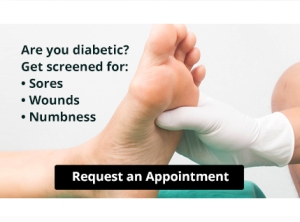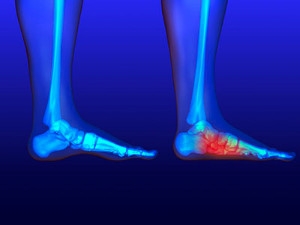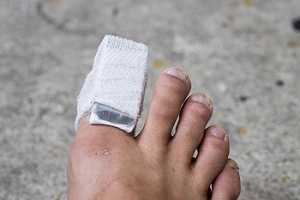
Do Feet Become Larger During Pregnancy?
 Many pregnant women notice their feet become larger as their pregnancy develops. This is often a result of additional weight gain caused by the growing fetus. Changes in hormone levels may cause the joints in the feet to become loose. Swollen feet are a common symptom that affect many pregnant women. Mild relief can be found while resting and elevating the feet. Additionally, it may be beneficial to perform gentle foot stretches, and this can be helpful in reducing excess fluid that may accumulate in the feet. It is important to wear shoes that fit correctly, and can offer the correct amount of support. Some pregnant women find it helpful to wear compression stockings in addition to wearing insoles, as they can add to the support of the shoe. If you have questions about how pregnancy affects the feet, please consult with a podiatrist who can provide you with the best information and recommendations.
Many pregnant women notice their feet become larger as their pregnancy develops. This is often a result of additional weight gain caused by the growing fetus. Changes in hormone levels may cause the joints in the feet to become loose. Swollen feet are a common symptom that affect many pregnant women. Mild relief can be found while resting and elevating the feet. Additionally, it may be beneficial to perform gentle foot stretches, and this can be helpful in reducing excess fluid that may accumulate in the feet. It is important to wear shoes that fit correctly, and can offer the correct amount of support. Some pregnant women find it helpful to wear compression stockings in addition to wearing insoles, as they can add to the support of the shoe. If you have questions about how pregnancy affects the feet, please consult with a podiatrist who can provide you with the best information and recommendations.
Pregnant women with swollen feet can be treated with a variety of different methods that are readily available. For more information about other cures for swollen feet during pregnancy, consult with Corinne R. Kauderer, DPM from Dyker Heights Foot & Ankle. Our doctor will attend to all of your foot and ankle needs.
What Foot Problems Can Arise During Pregnancy?
One problem that can occur is overpronation, which occurs when the arch of the foot flattens and tends to roll inward. This can cause pain and discomfort in your heels while you’re walking or even just standing up, trying to support your baby.
Another problem is edema, or swelling in the extremities. This often affects the feet during pregnancy but tends to occur in the later stages.
How Can I Keep My Feet Healthy During Pregnancy?
- Wearing orthotics can provide extra support for the feet and help distribute weight evenly
- Minimize the amount of time spent walking barefoot
- Wear shoes with good arch support
- Wear shoes that allow for good circulation to the feet
- Elevate feet if you experience swelling
- Massage your feet
- Get regular, light exercise, such as walking, to promote blood circulation to the feet
If you have any questions please feel free to contact one of our offices located in Brooklyn, NY and Old Bridge, NJ . We offer the newest diagnostic and treatment technologies for all your foot and ankle needs.
Foot Care for Pregnant Women
The natural weight that pregnant women gain causes their center of gravity to be completely altered. This causes them to have a new weight-bearing stance which adds pressure to the knees and feet. As a result, pregnant women often experience severe foot pain. The two most common foot issues experienced by women in their pregnancies are edema and over-pronation. It is important for all pregnant women to learn more about how to take care of their feet so they are more comfortable during their pregnancy.
Over-pronation, which is commonly referred to as flat feet, is caused when a person’s arch flattens out upon weight bearing. This causes the person’s feet to roll inward while walking. Pregnant women often experience this due to the sudden weight they gain.
Edema, also referred as swelling in the feet, typically occurs in the later part of the pregnancy. It is the result of the extra blood accumulated in the pregnant woman’s body. The enlarged uterus puts more pressure on the blood vessels in the pelvis which causes leg circulation to slow down. This causes blood to pool in the lower extremities.
Fortunately, there are ways to treat both edema and over-pronation. Edema can be treated by elevating the foot as often as possible. Wearing proper fitting footwear will also be helpful for those with edema. A treatment method for over-pronation could be orthotics. Orthotic inserts should be designed with appropriate arch support and medial rear foot for your foot.
It is best for pregnant women to buy new shoes during the day, because this is the time where swelling is at its peak. Pregnant women also shouldn’t rush when buying shoes. It is always advised that you make sure your shoes fit properly but this is especially important during pregnancy.
If you are a pregnant woman, you should consult with a podiatrist in order to make sure your feet are healthy throughout the entirety of your pregnancy.
Foot Orthotics
Orthotics are shoe inserts that are meant to correct an irregular walking gait or provide cushioning to the feet. Orthotics come in a variety of different models and sizes, including over-the-counter and customizable variants. Customizable orthotics can be shaped and contoured to fit inside a specific shoe and are typically prescribed through a podiatrist who specializes in customized footwear and orthotics design and management.
Orthotics are beneficial because they can help prevent injuries from occurring and provide cushioning to keep pain levels down to a minimum. They also allow for the correct positioning of the feet. Orthotics can act as shock absorbers to help remove pressure from the foot and ankle. Therefore, orthotics can make bodily movements, such as walking and running, become more comfortable as well as help prevent the development of certain foot conditions.
Orthotics alleviate pain and make the foot more comfortable by slightly altering the angle at which the foot strikes the ground surface, therefore controlling the movement of the foot and ankle. Orthotics come in different variants and can be made of various materials. To determine what type of orthotic is most suited to your feet and your needs, it is best to consult your podiatrist. He or she will be able to recommend a type of orthotic that can help improve your foot function or prescribe a custom orthotic to best fit your feet.
Wounds That Don't Heal Need to Be Checked
Flat Feet Symptoms and Causes
You have flat feet when the en tire soles of your feet can touch the floor when you stand up. It is a very common and usually painless condition that occurs when the arches do not develop during childhood. It can also happen after an injury or from the stress brought upon by age. The majority of people that have flat feet will not show any signs or symptoms. Occasionally foot pain can surface in the heel or arch area. Flat feet is most common in infants and toddlers as the arches of their feet have yet to develop at this age. Most arches will develop throughout childhood, but there are some that will never develop them. Factors that can increase your risk of flat feet include obesity, diabetes, rheumatoid arthritis, injury to the foot or ankle and aging. If you are experiencing pain as a result of flat feet, it is advised that you consult with a podiatrist.
tire soles of your feet can touch the floor when you stand up. It is a very common and usually painless condition that occurs when the arches do not develop during childhood. It can also happen after an injury or from the stress brought upon by age. The majority of people that have flat feet will not show any signs or symptoms. Occasionally foot pain can surface in the heel or arch area. Flat feet is most common in infants and toddlers as the arches of their feet have yet to develop at this age. Most arches will develop throughout childhood, but there are some that will never develop them. Factors that can increase your risk of flat feet include obesity, diabetes, rheumatoid arthritis, injury to the foot or ankle and aging. If you are experiencing pain as a result of flat feet, it is advised that you consult with a podiatrist.
Flatfoot is a condition many people suffer from. If you have flat feet, contact Corinne R. Kauderer, DPM from Dyker Heights Foot & Ankle. Our doctor will treat your foot and ankle needs.
What Are Flat Feet?
Flatfoot is a condition in which the arch of the foot is depressed and the sole of the foot is almost completely in contact with the ground. About 20-30% of the population generally has flat feet because their arches never formed during growth.
Conditions & Problems:
Having flat feet makes it difficult to run or walk because of the stress placed on the ankles.
Alignment – The general alignment of your legs can be disrupted, because the ankles move inward which can cause major discomfort.
Knees – If you have complications with your knees, flat feet can be a contributor to arthritis in that area.
Symptoms
- Pain around the heel or arch area
- Trouble standing on the tip toe
- Swelling around the inside of the ankle
- Flat look to one or both feet
- Having your shoes feel uneven when worn
Treatment
If you are experiencing pain and stress on the foot you may weaken the posterior tibial tendon, which runs around the inside of the ankle.
If you have any questions please feel free to contact one of our offices located in Brooklyn, NY and Old Bridge, NJ . We offer the newest diagnostic and treatment technologies for all your foot and ankle needs.
Flat Feet
Flatfoot is a foot condition in which the arch of the foot has either partially or totally dropped or has never developed. While it is common in babies and small children, it can become a problem for them in adulthood if the arch never forms. For adults, the development of flat feet can be brought upon by injury, as a result of pregnancy due to increased elasticity, or obesity. Those who have health concerns such as rheumatoid arthritis or diabetes may also be at greater risk for developing the condition.
If you suspect that you have flat feet, it is best to consult your podiatrist. Your foot doctor will examine the suspected foot and observe how it looks while you sit and stand. He or she may take an X-ray to determine how serious the condition is. Some common signs of flatfoot include toe drift, in which the toes and front part of the foot point outward, a short Achilles tendon, and a heel that tilts outwardly while the ankle tilts inward.
Once flatfoot has been diagnosed, your podiatrist may suggest one of several treatment options. Flat feet can be rigid, in which the feet appear to have no arch even when the person is not standing; or flexible, in which the person appears to have an arch while not standing, but once standing the arch disappears. Those with flexible flatfoot may be told to reduce any activities that cause pain and to avoid extended periods of walking or standing. Another suggestion may be weight loss, as excessive weight may be placing pressure on the arches
In few cases, if the condition is severe and all other methods have been exhausted surgery may be required. This is normally avoided, however, due to a lengthy recovery time and high cost.
How to Protect Your Feet During the Work Day
 There are many people who spend the majority of their working day standing or walking. Research has indicated it is beneficial to wear shoes that fit properly, and this may help to prevent painful foot conditions from developing. It is helpful to make sure there is enough room for the toes to move freely in, and the feet will feel better when there is adequate cushioning and support. Resting the feet as frequently as possible may aid in reducing foot pain that comes from standing for extended periods of time. Additionally, it is important to choose shoes and socks that are made of breathable materials, as this can help to provide maximum comfort. Please consult with a podiatrist if you would like additional information about how to protect your feet while working.
There are many people who spend the majority of their working day standing or walking. Research has indicated it is beneficial to wear shoes that fit properly, and this may help to prevent painful foot conditions from developing. It is helpful to make sure there is enough room for the toes to move freely in, and the feet will feel better when there is adequate cushioning and support. Resting the feet as frequently as possible may aid in reducing foot pain that comes from standing for extended periods of time. Additionally, it is important to choose shoes and socks that are made of breathable materials, as this can help to provide maximum comfort. Please consult with a podiatrist if you would like additional information about how to protect your feet while working.
While working on the feet, it is important to take the proper care of them. For more information about working on your feet, contact Corinne R. Kauderer, DPM from Dyker Heights Foot & Ankle. Our doctor will treat your foot and ankle needs.
Working on Your Feet
Standing on your feet for long periods of time can cause stress and pain in your feet. Your whole body may experience change in terms of posture, back pain, bunions, callouses and or plantar warts. There are ways to avoid these conditions with proper foot care, smart choices and correct posture.
Positive Changes
Negative heeled shoe – Choosing this shoe type places the heel slightly lower than the ball of the foot. These are great for overall foot health. Find shoes that fit you correctly.
Go barefoot – Our feet were not designed to be enclosed for all hours of the day. Try to periodically expose your feet to air.
Eliminate Pain
Foot Exercises – Performing simple exercises, incorporating yoga and doing stretches are beneficial. This will allow increased blood flow to the area and muscles of the foot.
Achilles tendon – Stretching the foot out flat on the floor will relax the calf muscles and tendon. These exercises can be performed almost anywhere. Make sure you add these exercises to your daily regimen.
With a little bit of this information and knowing more about foot health, you will notice changes. Foot stretches and proper footwear will help with pain and prevent further issues.
If you have any questions please feel free to contact one of our offices located in Brooklyn, NY and Old Bridge, NJ . We offer the newest diagnostic and treatment technologies for all your foot and ankle needs.
Sports Related Foot And Ankle Injuries
Foot and ankle injuries are common among people who participate in sports. Several factors contribute to this. They include failing to stretch or warm up properly, not wearing the proper type of shoe and not taping or providing other types of support for the ankle or foot. The most common foot and ankle injuries suffered by people involved in sports are plantar fasciitis, ankle sprains and Achilles tendon damage or ruptures. If not treated properly, they can lead to permanent disability.
Treating these injuries is relatively simple if they are identified and addressed early. Many athletes dismiss the initial aches and pains associated with injury as just soreness or tired muscles. Their first response is usually to try to work through it. This can lead to serious problems. Many minor injuries are made far more serious when athletes continue to put strain and pressure on them. That attitude can change a mild strain into a serious strain and a minor tear into a rupture. Athletes should have unusual aches and pains evaluated by a skilled medical professional.
Plantar fasciitis is a painful injury. It is inflammation of the plantar fascia, the thick band of tissue running from the heel to the base of the toes. If left untreated, it can lead to a degenerative disease called plantar fasciosis. There are several effective treatments for this ailment. Doctors often prescribe rest, massages, stretching, night splints, physical therapy, anti-inflammatory medication, corticosteroids or surgery, usually in that order. The most effective treatment for plantar fasciitis is orthotics, which offers foot support. Surgery is occasionally used as a last resort, but it comes with the risk of nerve damage and infection and often does not stop the pain.
The Achilles tendon is the largest tendon in the body. It connects the calf muscles to the heel bone. Running, jumping and walking all impact this tendon. Two common injuries to the Achilles tendon are tendonitis and a rupture of the tendon. Tendonitis is inflammation in the tendon often caused by an increase in the amount of stress placed on it. Non-surgical treatments include rest, ice or anti-inflammatory medication. A rupture (tear) of the Achilles tendon can be treated by placing the lower leg in a cast for several weeks or with surgery. Many physicians feel surgery is the better option because it lowers the risk of re-ruptures. Both methods require 4 to 6 months of rehabilitation.
Ankle sprains are the most common sports related foot and ankle injury. A sprain occurs when the ligament holding the ankle bones and joint stretches beyond its normal range. It can be treated non-surgically with a combination of rest, ice wrapped around the joint for 30 minutes immediately after injury, compression by a bandage and elevating the ankle above the heart for 48 hours. This combination is referred to as RICE. Severe ankle sprains in which the ligaments are torn may require reconstructive surgery followed by rehabilitation.
Different Types of Toe Fractures
 The toes play a significant role in maintaining balance in the body while standing, in addition to pursuing walking and running activities. The bones are small, and can easily break if something heavy is dropped on one of them, or if it bangs against a piece of furniture. There are noticeable symptoms of a broken toe. These often consist of immediate pain, discomfort, redness, and the affected area may appear to be bruised and swollen. Research has shown there are several different types of breaks. A traumatic fracture consists of a sudden break, and this can occur from falling, or severely stubbing the toe. Additionally, if extended periods of time are spent in running activities, the toes may endure stress fractures. This can be a result of a gradual weakening of the bones in the toes. A fracture is considered to be severe if a bone is protruding from the skin, and an infection may occur from the open wound. If you have broken your toe, it is suggested to seek the counsel of a podiatrist who can properly diagnose and treat this condition.
The toes play a significant role in maintaining balance in the body while standing, in addition to pursuing walking and running activities. The bones are small, and can easily break if something heavy is dropped on one of them, or if it bangs against a piece of furniture. There are noticeable symptoms of a broken toe. These often consist of immediate pain, discomfort, redness, and the affected area may appear to be bruised and swollen. Research has shown there are several different types of breaks. A traumatic fracture consists of a sudden break, and this can occur from falling, or severely stubbing the toe. Additionally, if extended periods of time are spent in running activities, the toes may endure stress fractures. This can be a result of a gradual weakening of the bones in the toes. A fracture is considered to be severe if a bone is protruding from the skin, and an infection may occur from the open wound. If you have broken your toe, it is suggested to seek the counsel of a podiatrist who can properly diagnose and treat this condition.
A broken toe can be very painful and lead to complications if not properly fixed. If you have any concerns about your feet, contact Corinne R. Kauderer, DPM from Dyker Heights Foot & Ankle. Our doctor will treat your foot and ankle needs.
What to Know About a Broken Toe
Although most people try to avoid foot trauma such as banging, stubbing, or dropping heavy objects on their feet, the unfortunate fact is that it is a common occurrence. Given the fact that toes are positioned in front of the feet, they typically sustain the brunt of such trauma. When trauma occurs to a toe, the result can be a painful break (fracture).
Symptoms of a Broken Toe
- Throbbing pain
- Swelling
- Bruising on the skin and toenail
- The inability to move the toe
- Toe appears crooked or disfigured
- Tingling or numbness in the toe
Generally, it is best to stay off of the injured toe with the affected foot elevated.
Severe toe fractures may be treated with a splint, cast, and in some cases, minor surgery. Due to its position and the pressure it endures with daily activity, future complications can occur if the big toe is not properly treated.
If you have any questions please feel free to contact one of our offices located in Brooklyn, NY and Old Bridge, NJ . We offer the newest diagnostic and treatment technologies for all your foot and ankle needs.















